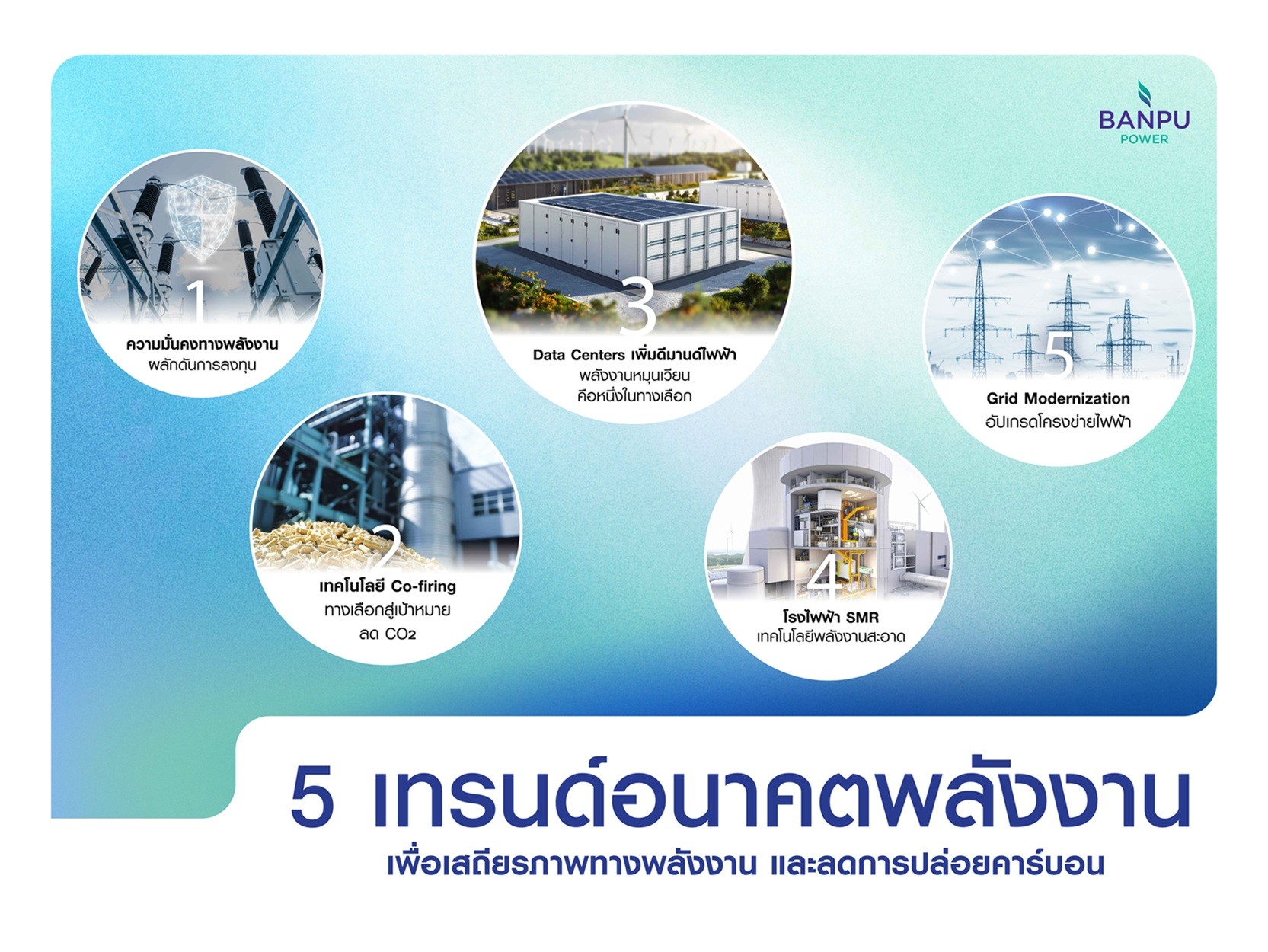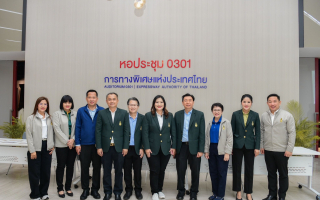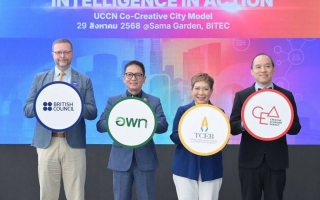BPP เผย 5 เทรนด์อนาคตพลังงาน สร้างความมั่นคง-ลด CO₂

BPP เผย 5 เทรนด์อนาคตพลังงาน สร้างความมั่นคง-ลด CO₂
ปัจจุบันโลกกำลังเผชิญกับความท้าทายด้านพลังงาน เมื่อความต้องการใช้ไฟฟ้าเพิ่มขึ้นอย่างรวดเร็วจากหลายปัจจัย เช่น อุณหภูมิที่สูงขึ้นอย่างต่อเนื่อง การเปลี่ยนมาใช้ไฟฟ้าแทนเชื้อเพลิงอื่น ๆ (Electrification) และการเข้าสู่ยุคดิจิทัล (Digitalization) ที่ทุกอย่างเชื่อมโยงผ่านเทคโนโลยี ขณะเดียวกันความขัดแย้งด้านภูมิรัฐศาสตร์และแรงกดดันด้านสิ่งแวดล้อม ทำให้ทุกภาคส่วนเร่งสร้างระบบพลังงานที่มั่นคงและยั่งยืน โดยเทคโนโลยีและนวัตกรรมพลังงานมีบทบาทสำคัญในการปรับเปลี่ยนรูปแบบการผลิตและการใช้พลังงาน ที่เพิ่มประสิทธิภาพและความยืดหยุ่น พร้อมเดินหน้าสู่ความมั่นคง
ด้านพลังงานและการลดการปล่อยคาร์บอนไดออกไซด์ (Decarbonization) เพื่อขับเคลื่อนการเติบโตทางธุรกิจให้สอดรับกับภูมิทัศน์พลังงานที่กำลังเปลี่ยนแปลงไป (Energy Landscape Transformation) บริษัท บ้านปู เพาเวอร์ จำกัด (มหาชน) หรือ BPP ในฐานะผู้ผลิตพลังงานระดับสากล ได้รวบรวม 5 เทรนด์พลังงานสำคัญที่องค์กรธุรกิจควรจับตา ดังนี้
ความมั่นคงทางพลังงาน ปัจจัยสำคัญผลักดันการลงทุนทั่วโลก
รายงานล่าสุดจากองค์กรพลังงานระหว่างประเทศ (IEA) ระบุว่า “ความมั่นคงทางพลังงาน (Energy Security)”กลายเป็นแรงขับเคลื่อนสำคัญที่ทำให้การลงทุนด้านพลังงานทั่วโลกในปี 2025 พุ่งสูงถึง 3.3 ล้านล้านดอลลาร์สหรัฐ โดยแบ่งเป็นการลงทุนในพลังงานจากเชื้อเพลิงฟอสซิล เช่น น้ำมัน ก๊าซธรรมชาติ และถ่านหิน รวมมูลค่า 1.1 ล้านล้านดอลลาร์สหรัฐ และการลงทุนในเทคโนโลยีพลังงานสะอาด เช่น พลังงานหมุนเวียน พลังงานนิวเคลียร์ ระบบโครงข่ายไฟฟ้า และแบตเตอรี่ รวมมูลค่า 2.2 ล้านล้านดอลลาร์สหรัฐ[1] ท่ามกลางความต้องการใช้ไฟฟ้าที่เพิ่มขึ้นอย่างต่อเนื่องและความกังวลด้านความมั่นคงทางพลังงาน ภาครัฐและภาคธุรกิจทั่วโลกจึงเร่งวางแผนรับมือความเสี่ยงรอบด้านผ่านการลงทุนที่สมดุลทั้งในพลังงานดั้งเดิมและพลังงานสะอาดเพื่อรักษาความต่อเนื่องในการใช้ไฟฟ้า สร้างความมั่นใจว่าจะมีไฟฟ้าที่เพียงพอต่อความต้องการใช้งานภายในประเทศอย่างยั่งยืน พร้อมเสริมความมั่นคงทางธุรกิจและเศรษฐกิจระดับประเทศในระยะยาว
เทคโนโลยี Co-firing ทางเลือกสู่เป้าหมายลด CO₂
ปัจจุบันโรงไฟฟ้าพลังงานความร้อนยังคงเป็นแหล่งผลิตไฟฟ้าหลักที่ช่วยให้เรามีไฟฟ้าใช้อย่างต่อเนื่อง รองรับการใช้ชีวิตและกิจกรรมทางเศรษฐกิจได้อย่างไม่สะดุด เทคโนโลยี Co-firing คือ การนำเชื้อเพลิงทางเลือก เช่น ชีวมวล (Biomass), ไฮโดรเจน (Hydrogen) และแอมโมเนีย (Ammonia) มาใช้ร่วมกับเชื้อเพลิงหลักอย่างฟอสซิลในโรงไฟฟ้า เพื่อช่วยลดการปล่อย CO₂ โดยหลายประเทศให้ความสนใจและเริ่มทดลองใช้งานจริงอย่างเป็นรูปธรรม เช่น จีน ได้กำหนดให้โรงไฟฟ้าถ่านหินที่ผ่านการปรับปรุงหรือสร้างใหม่ต้องสามารถผสมชีวมวลหรือแอมโมเนียไม่น้อยกว่า 10%[2] ภายในปี 2027 เพื่อบรรลุเป้าหมายลด CO₂ ลง 50% เมื่อเทียบจากระดับการปล่อย CO₂ ในปี 2023[3] ตามแผนปฏิบัติการ “Low-Carbon Transformation of Coal Power Plants (2024–2027)” ด้านไทย แผนพัฒนากำลังผลิตไฟฟ้า (PDP 2024) ได้มีการวางแผนใช้ไฮโดรเจนเริ่มต้นที่ 5% ผสมกับก๊าซธรรมชาตินำร่องใช้ในโรงไฟฟ้าในช่วงปี 2030-2037[4] ซึ่งเทคโนโลยี Co-firing กำลังเปลี่ยนโฉมโรงไฟฟ้าพลังงานความร้อนแบบเดิมให้เป็นมิตรต่อสิ่งแวดล้อมมากขึ้น
Data Centers โตดันดีมานด์ไฟฟ้าพุ่ง พลังงานหมุนเวียน หนึ่งในทางเลือกที่ตอบโจทย์
พลังงานหมุนเวียนเติบโตต่อเนื่องเพื่อตอบรับความต้องการไฟฟ้าที่เพิ่มขึ้นจากเศรษฐกิจดิจิทัลและศูนย์ข้อมูล (Data Centers) โดยองค์กรพลังงานระหว่างประเทศ (IEA) คาดว่าภายในปี 2030 ความต้องการใช้ไฟฟ้าจากศูนย์ข้อมูลจะเพิ่มขึ้นกว่า 2 เท่า เป็นประมาณ 945 เทราวัตต์-ชั่วโมง[5] โดยกลุ่มยักษ์ใหญ่ด้านเทคโนโลยี เช่น Amazon Web Services ได้ตั้งเป้าใช้พลังงานหมุนเวียน 100% ในศูนย์ข้อมูล ภายในปี 2025[6] ขณะที่ Microsoft และ Google Cloud ได้ขยายความมุ่งมั่นไปสู่การใช้พลังงานที่ปราศจากคาร์บอน (Carbon-Free Energy หรือ CFE) ตลอด 24 ชั่วโมง ภายในปี 2030[7] อย่างไรก็ตาม พลังงานความร้อนยังคงมีบทบาทสำคัญในการรักษาเสถียรภาพของระบบไฟฟ้า โดยเฉพาะในช่วงเวลาที่พลังงานหมุนเวียนไม่สามารถผลิตไฟฟ้าได้อย่างต่อเนื่อง รายงานจาก Precedence Research คาดว่า ตลาดโรงไฟฟ้าพลังงานความร้อนทั่วโลกจะมีมูลค่า 1.56ล้านล้านดอลลาร์สหรัฐในปี 2025 และจะเติบโตถึง 2.13 ล้านล้านดอลลาร์สหรัฐภายในปี 2034[8] นอกจากนี้ เทคโนโลยี ระบบกักเก็บพลังงานด้วยแบตเตอรี่ (Battery Energy Storage: BESS) กำลังมีบทบาทสำคัญในการสำรองและจ่ายไฟฟ้ากลับสู่ระบบในช่วงที่ไม่มีการผลิตไฟฟ้าจากพลังงานหมุนเวียน ทำให้บริหารความต้องการใช้ไฟฟ้าได้อย่างมีประสิทธิภาพ โดยตลาด BESS ในเอเชียแปซิฟิกคาดว่าจะมีมูลค่าสูงถึง 14.67 พันล้านดอลลาร์สหรัฐภายในปี 2033[9] สะท้อนว่า การเปลี่ยนผ่านด้านพลังงานยังคงต้องอาศัยการผสมผสานระหว่างพลังงานความร้อน พลังงานหมุนเวียน และเทคโนโลยีพลังงาน เพื่อเสริมความมั่นคงและความยืดหยุ่นของระบบไฟฟ้า
โรงไฟฟ้านิวเคลียร์ขนาดเล็ก (Small Modular Reactor: SMR) เทคโนโลยีพลังงานสะอาด
โรงไฟฟ้านิวเคลียร์ขนาดเล็ก หรือ SMR คือ โรงไฟฟ้าพลังงานสะอาดที่ใช้ความร้อนจากปฏิกิริยานิวเคลียร์แบบฟิชชัน (Nuclear Fission) ในการผลิตไฟฟ้า โดยมีจุดเด่นสำคัญคือ การบริหารจัดการวัสดุกัมมันตรังสีใช้แล้วอย่างมีประสิทธิภาพ และการออกแบบที่ส่งเสริมความปลอดภัยทางนิวเคลียร์ด้วยระบบระบายความร้อนที่ช่วยรักษาอุณหภูมิให้อยู่ในระดับที่เหมาะสม ซึ่งเครื่องปฏิกรณ์ถูกออกแบบให้เป็นโมดูลขนาดเล็กช่วยลดระยะเวลาก่อสร้างและติดตั้งจาก 5-6 ปี เหลือเพียง 3-4 ปี โดยมีกำลังผลิตสูงสุดถึง 300 เมกะวัตต์ (MW) ซึ่งช่วยเพิ่มความยืดหยุ่นในการผลิตไฟฟ้าได้ต่อเนื่องโดยไม่ปล่อย CO₂ ปัจจุบันหลายประเทศอยู่ระหว่างพัฒนาและทดลองการใช้งาน เช่น จีน มีโครงการ ACP100 หรือ Linglong One กำลังการผลิตประมาณ 125 เมกะวัตต์ ตั้งอยู่ที่มณฑลไห่หนาน คาดว่าจะเริ่มดำเนินการในปี 2026[10] ขณะที่ในสหรัฐฯ ได้อนุมัติแบบเครื่องปฏิกรณ์ SMR ขนาด 77 เมกะวัตต์ของ NuScale Power[11] สำหรับไทย ในร่างแผนพัฒนากำลังผลิตไฟฟ้าฉบับใหม่ (PDP2024) ได้มีการบรรจุแผนสร้างโรงไฟฟ้านิวเคลียร์ขนาดเล็ก 2 แห่ง ขนาดกำลังผลิตแห่งละ 300 เมกะวัตต์ โดยอยู่ระหว่างเตรียมโครงสร้างพื้นฐานเพื่อรองรับการพัฒนาในอนาคต[12] เทคโนโลยี SMR จึงเป็นอีกหนึ่งทางเลือกที่น่าจับตามองในการเสริมความมั่นคงด้านพลังงาน และลดการปล่อยคาร์บอนในระยะยาว
Grid Modernization อัปเกรดโครงข่ายไฟฟ้าให้ชาญฉลาดและทันสมัยยิ่งขึ้น
Grid Modernization คือ การปรับปรุงระบบโครงข่ายไฟฟ้าให้ชาญฉลาด ยืดหยุ่น และมีประสิทธิภาพสูงขึ้น เพื่อรองรับแหล่งพลังงานที่หลากหลาย เช่น พลังงานหมุนเวียน และตอบโจทย์การใช้พลังงานในอนาคต โดยการพัฒนาโครงสร้างพื้นฐานและการนำเทคโนโลยีดิจิทัลมาใช้ เช่น ระบบควบคุมอัตโนมัติ การวิเคราะห์ข้อมูล และการจัดการโหลดไฟฟ้าแบบเรียลไทม์ ช่วยลดการปล่อย CO₂ และรักษาเสถียรภาพของระบบไฟฟ้าโดยรวม[13] ในเอเชียแปซิฟิก ตลาด Grid Modernization คาดว่าจะเติบโตจาก 12.7 พันล้านดอลลาร์สหรัฐในปี 2024 เป็นกว่า 51.5 พันล้านดอลลาร์สหรัฐภายในปี 2032[14] ขณะที่สหรัฐฯ ดำเนินโครงการ Grid Resilience and Innovation Partnerships (GRIP) มูลค่า 10.5 พันล้านดอลลาร์สหรัฐ เพื่อเพิ่มความยืดหยุ่นของโครงข่ายไฟฟ้าในการรับมือกับสภาพอากาศที่ผันผวน[15] ส่วนจีนมีการประกาศแผนลงทุนในระบบโครงข่ายไฟฟ้ามูลค่าสูงถึง 800 พันล้านดอลลาร์สหรัฐ ภายในปี 2030 เพื่อรองรับความต้องการไฟที่เพิ่มขึ้นและสนับสนุน
การเปลี่ยนผ่านด้านพลังงาน[16]
อนาคตพลังงานกำลังขับเคลื่อนด้วยเทคโนโลยีและนวัตกรรม เพื่อสร้างระบบพลังงานที่มั่นคง ยืดหยุ่น และลดการปล่อยคาร์บอนอย่างเป็นรูปธรรม แนวโน้มนี้ไม่ได้เป็นเพียงนโยบาย แต่เกิดขึ้นจริงในภาคธุรกิจทั่วโลก ในฐานะผู้ดำเนินธุรกิจพลังงานใน 8 ประเทศทั่วโลก BPP มุ่งมั่นผลิตและพัฒนาพลังงานคุณภาพสูงที่เป็นมิตรต่อสิ่งแวดล้อม ควบคู่กับการลดการปล่อยคาร์บอนไดออกไซด์ เพื่อสนับสนุนความมั่นคงด้านพลังงานและการเติบโตอย่างยั่งยืนในทุกประเทศที่ดำเนินธุรกิจ
ศึกษาข้อมูลเพิ่มเติมเกี่ยวกับธุรกิจ BPP ได้ที่ www.banpupower.com
[1] อ้างอิงจาก Energy Connects - Global energy investment to cross $3.3 trillion in 2025 amid energy security concerns
[2] อ้างอิงจาก China Coal Action Plan Offers Roadmap for Coal Phase-Out, Asia Research and Engagement
[3] อ้างอิงจาก Ammonia Energy - China: renewable ammonia to reduce power generation emissions
[4] อ้างอิงจาก Thai PBS - PDP ฉบับใหม่เริ่มใช้ พลังงานไฮโดรเจนในปี 2030
[5] อ้างอิงจาก Energy and AI, International Energy Agency (IEA)
[6] อ้างอิงจาก Cedara - Tracking the Transition to Renewable Energy Across Data Centers
[7] อ้างอิงจาก Eurelectric - Exploring the 24/7 carbon-free energy (CFE) ecosystem – the future of corporate procurement
[8] อ้างอิงจาก Precedence Research - Thermal Power Plant Market Size, Share and Trends 2025 to 2034
[9] อ้างอิงจาก Globe News Wire - Asia-Pacific's Liquid Cooling Market for Stationary Battery Energy Storage Systems (BESS) 2025-2033: Analysis of Trends, Supply Chain, R&D, Regulations, Investment & Funding, Case Studies and More
[10] อ้างอิงจาก Energy News - ACP100, China’s first modular reactor for sustainable nuclear energy
[11] อ้างอิงจาก Reuters - US approves NuScale's bigger nuclear reactor design
[12] อ้างอิงจาก กรุงเทพธุรกิจ - ผ่าแผนลงทุนโรงไฟฟ้า SMR โจทย์ร้อนนำร่องนิวเคลียร์ขนาดเล็ก 600 เมก
[13] อ้างอิงจาก Sustainability Directory - What Is Grid Modernization?
[14] อ้างอิงจาก Credence Research - Asia Pacific Grid Modernization Market
[15] อ้างอิงจาก U.S. Department of Energy - Grid Resilience and Innovation Partnerships (GRIP) Program
[16] อ้างอิงจาก Climate Insider - China Plans to Invest $800 Billion in Creaking Electricity Grid to Accelerate the Green Transition
BPP Reveals 5 Energy Trends Shaping a Secure and Low-Carbon Future
As global energy systems face unprecedented challenges, electricity demand is soaring due to multiple factors: persistently rising temperatures, the shift toward electrification, and the digitalization of daily life driven by interconnected technologies. Simultaneously, geopolitical tensions and environmental pressures are accelerating the global push for secure and sustainable energy systems. Energy technologies and innovations are playing an increasingly critical role in transforming how energy is generated and consumed, enhancing efficiency and flexibility while advancing energy security and decarbonization. In response to the evolving energy landscape, Banpu Power PCL (BPP), an international energy producer company, has identified five major energy trends that businesses should closely track to stay ahead.
1. Energy Security: A Key Driver of Global Investment
According to the latest report by the International Energy Agency (IEA), energy security has emerged as a primary driver behind global energy investments, which are projected to reach USD 3.3 trillion in 2025. Of this, USD 1.1 trillion will be allocated to fossil fuels—including oil, natural gas, and coal—while USD 2.2 trillion is earmarked for clean energy technologies such as renewables, nuclear, electricity grids, and batteries.[1] With electricity demand climbing steadily and growing concerns about energy stability, governments and businesses worldwide are actively balancing investments in both conventional and clean energy sources. The goal is to ensure an uninterrupted and sustainable power supply that meets domestic demand, while also strengthening long-term business resilience and national economic security.
2. Co-Firing Technology: A Pathway to Reducing CO₂ Emissions
Thermal power plants remain a critical component of electricity generation, ensuring a steady supply for households and economic activities. Co-firing technology blends alternative fuels such as biomass, hydrogen, or ammonia with fossil fuels in power plants. It is gaining traction as a practical method for reducing CO₂ emissions. Several countries have already rolled out concrete plans. For example, China requires that all upgraded or newly built coal-fired power plants be capable of co-firing at least 10% biomass or ammonia[2] by 2027, aiming to halve CO₂ emissions by 50% compared to 2023 levels under its “Low-Carbon Transformation of Coal Power Plants” plan (2024–2027).[3] In Thailand, the latest “Power Development Plan” (PDP 2024) outlines a roadmap for blending 5% hydrogen into natural gas for power generation between 2030 and 2037.[4] Co-firing is transforming conventional thermal power plants to become more environmentally sustainable.
3. Data Center Boom Pushes Power Demand; Renewables Emerge as a Key Solution
Renewable energy is seeing sustained growth as it responds to surging electricity demand driven by the digital economy and the expansion of data centers. According to the IEA, electricity consumption from data centers is expected to more than double by 2030, reaching approximately 945 terawatt-hours.[5] Tech giants like Amazon Web Services have committed to powering their data centers with 100% renewable energy by 2025[6], while Microsoft and Google Cloud have gone further with pledges to achieve 24/7 carbon-free energy (CFE) by 2030.[7] However, thermal power remains critical for maintaining grid stability, particularly during periods when renewable generation is intermittent. Research by Precedence Research projects that the global thermal power market will grow from USD 1.56 trillion in 2025 to USD 2.13 trillion by 2034.[8] This also includes technologies such as Battery Energy Storage Systems (BESS), which store electricity and dispatch it back to the grid when renewables are not generating power, helping to manage electricity demand more effectively. The BESS market in Asia-Pacific is projected to reach USD 14.67 billion by 2033.[9] This underscores that the energy transition will continue to rely on a balanced mix of thermal power, renewables, and energy technologies to ensure grid resilience and flexibility.
4. Small Modular Reactor (SMR): Clean Energy Technology
A small modular reactor (SMR) is a clean-energy power plant that harnesses nuclear fission to generate electricity. A key advantage lies in its efficient management of spent radioactive materials and a design that enhances nuclear safety through advanced cooling systems to maintain optimal operating temperatures. Designed as compact modules with capacities of up to 300 megawatts (MW), SMRs can be constructed and deployed more quickly than traditional nuclear plants—typically within 3–4 years compared to 5–6 years for conventional facilities. They deliver continuous, CO₂-free power with enhanced generation resilience. Several countries are making significant strides. China is developing the ACP100 “Linglong One,” situated in Hainan province, with a capacity of 125 MW and is expected to begin operations in 2026.[10] In the United States, the 77-MW NuScale Power SMR design has already received regulatory approval.[11] In Thailand, the draft Power Development Plan 2024 (PDP 2024) includes plans for two 300-MW SMRs, with work underway to build the necessary infrastructure to support future deployment.[12] SMRs represent a promising pathway toward strengthening energy security and reducing carbon emissions over the long term.
5. Grid Modernization: Upgrading the Power Grid to Be Smarter and More Advanced
Grid modernization involves upgrading electrical infrastructure to become smarter, more resilient, and more efficient, enabling it to handle diverse energy sources, including renewables, and meet future energy needs. Infrastructure improvements and the integration of digital technologies, such as automation systems, data analytics, and real-time load management, are central to reducing CO₂ emissions and maintaining system stability.[13] In the Asia-Pacific region, the grid modernization market is projected to grow from USD 12.7 billion in 2024 to over USD 51.5 billion by 2032.[14] The United States is advancing its ‘Grid Resilience and Innovation Partnerships’ (GRIP) program with a USD 10.5 billion budget to strengthen grid resilience against climate volatility.[15] Meanwhile, China plans to invest USD 800 billion in grid upgrades by 2030 to meet rising electricity demand and support its energy transition.[16]
Looking ahead, energy systems worldwide are being shaped by technology and innovation to deliver secure, flexible, and low carbon energy solutions. This shift is no longer a distant policy aspiration but a reality unfolding across industries globally. As an energy leader operating in eight countries, BPP remains committed to producing high-quality, environmentally friendly power while advancing decarbonization. The company’s mission is to strengthen energy security and support sustainable growth in every market where it operates.
Learn more about BPP’s business at www.banpupower.com.
[1] Source: Energy Connects - Global energy investment to cross $3.3 trillion in 2025 amid energy security concerns
[2] Source: China Coal Action Plan Offers Roadmap for Coal Phase-Out, Asia Research and Engagement
[3] Source: Ammonia Energy - China: renewable ammonia to reduce power generation emissions
[4] Source: Thai PBS - PDP ฉบับใหม่เริ่มใช้ พลังงานไฮโดรเจนในปี 2030
[5] Source: Energy and AI, International Energy Agency (IEA)
[6] Source: Cedara - Tracking the Transition to Renewable Energy Across Data Centers
[7] Source: Eurelectric - Exploring the 24/7 carbon-free energy (CFE) ecosystem – the future of corporate procurement
[8] Source: Precedence Research - Thermal Power Plant Market Size, Share and Trends 2025 to 2034
[9] Source: Globe News Wire - Asia-Pacific's Liquid Cooling Market for Stationary Battery Energy Storage Systems (BESS) 2025-2033: Analysis of Trends, Supply Chain, R&D, Regulations, Investment & Funding, Case Studies and More
[10] Source: Energy News - ACP100, China’s first modular reactor for sustainable nuclear energy
[11] Source: Reuters - US approves NuScale's bigger nuclear reactor design
[12] Source: กรุงเทพธุรกิจ - ผ่าแผนลงทุนโรงไฟฟ้า SMR โจทย์ร้อนนำร่องนิวเคลียร์ขนาดเล็ก 600 เมก
[13] Source: Sustainability Directory - What Is Grid Modernization?
[14] Source: Credence Research - Asia Pacific Grid Modernization Market
[15] Source: U.S. Department of Energy - Grid Resilience and Innovation Partnerships (GRIP) Program
[16] Source: Climate Insider - China Plans to Invest $800 Billion in Creaking Electricity Grid to Accelerate the Green Transition




















